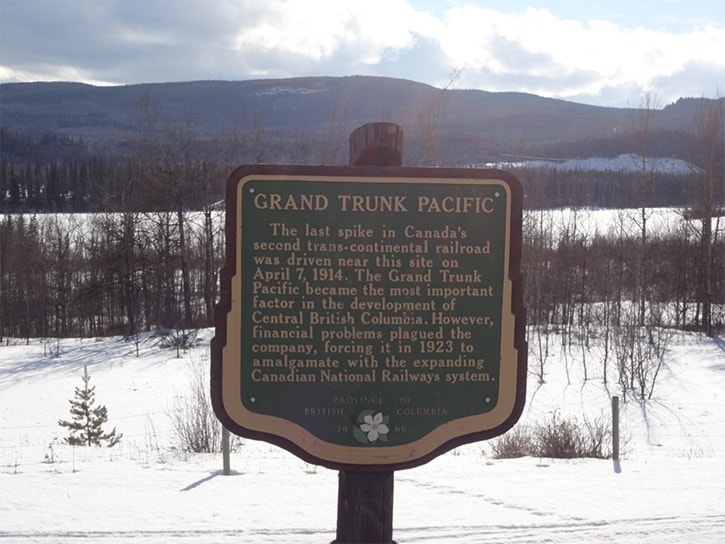Jeff Elder
Prince George
Heritage Commission
The last spike on the Grand Trunk Pacific Railway was driven 100 years ago just east of Fort Fraser on April 7, 1914.
A plaque near the site notes the importance of the railway in opening up central British Columbia and the financial problems that plagued the company, forcing it to amalgamate with Canadian National Railways in 1923.
Stretching 4,800 kilometres from Winnipeg to Prince Rupert, the Grand Trunk Pacific was Canada’s second transcontinental railway. The Canadian Pacific Railway was our first transcontinental railway, completed on Nov. 7, 1885, with the last spike driven at Craigellachie, B.C., near Revelstoke.
The weekly Fort George Herald newspaper of Saturday April 11, 1914 had Mon. Apr. 6 as the date of the last spike on the GTP. Several books give different locations and dates for the event. However, a 1974 letter from R.A. Harlow, a GTP surveyor who was at the last spike ceremony at Fort Fraser, confirmed April 7, 1914 as the correct date.
The event was described on the Herald’s front page.
“About twenty railway officials from Winnipeg arrived on the scene early in the day by special train, and although no public announcement had been made and no invitations issued there were over 1,500 persons present at the history-making ceremony. The track-laying gangs had previously arranged to have a mile of grade left open for a speed contest between the gangs of east and west. Both teams started off together but it was soon evident that the men from the east had more order and system in their work and were easy winners with 14 minutes to spare. A large flag pole was erected at the centre post where a large crowd gathered, and the official photographer and moving picture man got into position.
“When they came together there was a scene of great enthusiasm and the Union Jack was hoisted to the top of the pole. The last spikes, about nine on each rail, were driven by the several officials attending. In an interview before the ceremony Vice President Donaldson said that during the past week the GTP had shipped to Prince George alone no less than seven tons of settlers’ effects. This statement will give some idea to the rank and file of the rapidity with which settlers are pouring into the country.”
It would be several months before regular train travel was available for passengers wanting to travel from Fort George to Prince Rupert and points west due to washouts, settling of the track and maintenance required on the railway.
With the GTP completed, Harlow noted that “Canada had a coast-to-coast railway through the lowest mountain pass with the lowest gradient and flattest curves on the North American continent.”
A special two-week train trip is being offered April 1- 15 by Rail Travel Tours to mark the 100th anniversary of the last spike on the Grand Trunk Pacific, running from Toronto to Prince Rupert and back. The Railway and Forestry Museum on River Road will have an exhibit opening in late April on the anniversary of the arrival of rail in Fort George. The museum has a piece of the last rail laid on April 7, 1914 that will be on display (the rail was cut into quarter-inch slices that were polished, engraved and given as souvenirs to GTP officials).
